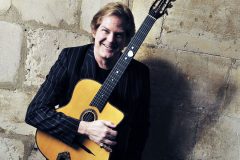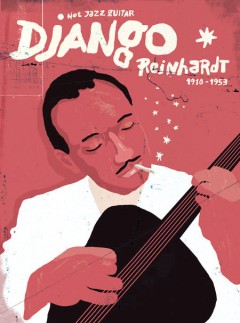Tales From The Road
John Jorgenson: Walking the Musical Soundscape of Gypsy Jazz

John Jorgenson

Jorgenson with his quintet

Django Reinhardt
In Woody Allen’s 1999 film, Sweet and Lowdown, set in the ’30s, Sean Penn plays a fictional jazz guitarist named Emmett Ray. He regards himself the second greatest guitar player in the world. The number one spot is reserved for Django Reinhardt. In the story Ray’s usual swagger and musical virtuoso evaporates in the presence of Reinhardt. In fact he fainted once in his presence.
Not so with John Jorgenson. As one of today’s most in-demand session guitar players, Jorgenson embraced Reinhardt when he first heard him. It was like coming home for him. He grew up in Southern California in the ’60s when the radio airwaves were dominated with the golden guitar music of some of the best rock musicians to grace the planet, including influences Jeff Beck, Carlos Santana, and Jimi Hendrix. The self-taught guitarist learned much of his skill by listening to recordings and picking up the music by ear. He has a rare kind of genius for an instrumentalist in that he’s equally comfortable and capable of playing Buck Owens, Beatles riffs, or jazz leads. In the late ’70s he played a unique rotation with three other musicians moving from Dixieland to bluegrass and gypsy jazz complete with costume changes. This served him well when he was recruited by Dan Fogelberg for his touring band. In 1986, Jorgenson became a founding member of the ground breaking Desert Rose Band with Chris Hillman of the Byrds. He had a successful seven-year run with the band, charting several hits and winning Live Instrumentalist of the Year from the Country Music Academy in Nashville. In 1994 he founded the award-winning guitar trio, the Hellacasters. This was followed by six years touring and recording with Elton John. During this time he played in sessions of such luminaries as Bob Dylan, Bonnie Raitt, Bob Seeger, and Brad Paisley. But, all along, he continued playing and recording his own unique take on the gypsy jazz he came to love with a heart-felt passion.
The genre originally earned its name that the music the gypsies of France were playing. Reinhardt was one of the key members of these musicians. With his violin partner Stéphane Grappelli he combined the popular 19th-century accordion-driven dance music called musette with the American jazz influence Duke Ellington. The result was an astounding, fierce, and passionate new sub-genre of jazz. It caught on in popularity throughout Europe. It would take decades before the music took hold in America.
When Jorgenson first heard Reinhardt, the artist was still in obscurity. Jorgenson released his first album influenced by gypsy jazz in 1988, After You’ve Gone. He has since released a series of albums that light a new fire to the genre. The production, musicianship on each album almost defies description. He brings the music to unexpected heights emphasizing the imagination that goes along with the speed and intricacies of the fret work, which keeps the listener engaged, at times in suspense — like witnessing a high-wire act, and always ready for more. He has also added orchestra into the mix to create a new vibrancy.
As a student of Reinhardt, Jorgenson learned his lessons well. His most recent releases, 2007’s Ultraspontane and 2010’s One Stolen Night, demonstrate the original vision of an artist who builds on a genre and creates something entirely new in the process. Today, John Jorgenson is considered one of the leading figures in this growing genre of music. He is currently on tour with his band, the John Jorgenson Quintet.
In a recent interview with the Troubadour Jorgenson explains how the guitar and gypsy jazz became such an uncompromising passion for him.
San Diego Troubadour: You’re known for your amazing guitar work. How did you get started playing?
John Jorgenson: I started on the piano first. My mom was a piano teacher. I played piano every day. I was five when I started on the piano. We had a ukulele around the house and I’d play around with that. I became interested in guitar when I was 10. That was a time when the Beatles were out and I started to hear pop music on the radio and realizing the sounds I liked were made by the guitar. I started playing guitar when I was 12.
SDT: How did you learn?
JJ: I learned mostly by ear. The first summer I got my guitar I had some free lessons at San Bernardino Valley College. I was supposed to be part of a class, but I was the only one that kept coming. The teacher was a blues player who showed me some blues scales. That’s how I started to learn how to improvise. I guess he showed me that so he wouldn’t have to do anything. I was able to start improvising pretty quickly and I understood how the scales worked with the song.
SDT: So you were listening and picking it up off records and the radio?
JJ: I would try to learn other people solos. But then I’d have a really hard time remembering them. I’d remember the first part of the song, then I’d forget. I’d remember the first few licks and then I’d forget. So, I’d make up my own parts to the song.
SDT: Who inspired you?
JJ: The Beatles, the Stones, the Byrds, the Buffalo Springfield, and Randy Bachman, too. I learned the opening licks to “No Time.” After that I moved to Hendrix, Led Zeppelin, and Humble Pie. I really liked Steve Howell from Yes. Then as I learned more I got into Jeff Beck and Santana, of course. Early on Creedence Clearwater Revival helped. Their songs were good to learn on because it wasn’t hard for someone young.
SDT: How did jazz come about as an interest for you?
JJ: I was aware of jazz players and I appreciated jazz guitar but I wasn’t inspired to pick it up to play it until I heard the ’30s swing. I was hearing Charlie Christian and Oscar Moore with the Nat King Cole Trio.
SDT: So the stage was set.
JJ: Yeah. When I heard Django, it was all over after that. I kept hearing his name. I would read an article about Clarence White and see Django’s name in there. I’d read about Jeff Beck and see his name there. He was an omnipresence to all the guitarists I was interested in. I loved the sound and style and how expressive, wild, and emotional the style was. It caught me and stayed with me from then on.
SDT: So, how did that come about for you?
JJ: In 1978 there was hardly anything about him anywhere that you could find. So I started doing research like an archeologist. I’d try to find what kind of pick and strings he used. I would just get immersed in his music; I found the biography by his manager Charles Delounay and I learned as much as there was to know at that time. I was working at Disneyland at that time. I’d drive up to Pasadena once a month. They had a jazz film series. I remember being really excited to see 30 seconds of Reinhardt. That was a really big deal. Back then there was no DVD or YouTube to see him play. There’s really only one piece of film footage where you can see him actually playing. I didn’t see it for years. It was supposedly lost. Someone sent me a video tape from France that was several generations old. I’d met a gypsy guitarist when I was over there touring. The tape was magical. That was quite a number of years after I tried to learn the style.
SDT: As you developed your style, was there a mentor or teacher who helped along the way?
JJ: No. There was just the records and trying to learn as much as I could by ear. There wasn’t anybody over here in America who was doing this kind of music. I met a few people that liked it as much as I did, but they didn’t know any more than I did about it.
SDT: How did that feel to you?
JJ: It was isolating but also kind of fun and exciting. There was a magazine called Hot Club News that was from Germany. I can’t read German, but I’d try to read them. I’d pour over these articles and pictures for hours trying to learn from them. There was such a vibrant gypsy jazz scene in Europe. I was jealous of that.
SDT: Is gypsy jazz rooted in American music?
JJ: Yes. That’s what makes this music unique. Basically Django and Stephen Grappelli were both very inspired by American jazz when they heard it. They were both working musicians around Paris in the late ’20s. They heard Louis Armstrong, Duke Ellington, and Benny Goodman, and they started trying to do that on guitar and violin, which was not only culturally different because it was American, but also people didn’t play jazz on the acoustic guitar and violin. It worked for them in a couple of different ways. They were the first jazz soloists that were not American. Also, jazz wasn’t considered to be very sophisticated then. But when it was played on stringed instruments like rhythm guitar instead of drums and violin and acoustic guitar instead of trumpet and sax, it became sophisticated and had an elegant quality. Because of this they were able to play the really ritzy parties in Paris where normal jazz bands weren’t able to play.
SDT: So, since that time, gypsy jazz has become a sub-genre?
JJ: Yeah, exactly. They were trying to copy American jazz but a different thing was being created. They were culturally different. So when the music came through their filter, it was like when the Beatles were trying to emulate the Everly Brothers, Eddie Cochran, Elvis, and Little Richard, but what came out was something completely different.
SDT: Sounds familiar.
JJ: Yeah. The same thing happened to me in this genre. I would’ve been happy to play in a Django tribute band. I would’ve been happy to play the music exactly the way it’s been played. But I ended up putting my own personality, my own influences, and my musical experience into the music and that ends up making it unique in the gypsy jazz format.
SDT: So the music keeps evolving and changing.
JJ: Yes. So, each new record is different. I’m working on new material and hope to have a new album out soon.
SDT: Well, I look forward to seeing you in concert this month. Thank you.
JJ: Thank you.
See John Jorgenson and his quintet in performance on Saturday, January 26, 7:30pm, at AMSD Concerts, 4650 Mansfield St., Normal Heights.






